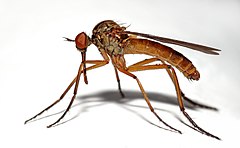Empididae
| Dagger flies and balloon flies Temporal range: Cretaceous - Recent |
|
|---|---|
 |
|
| Male Empis livida | |
| Scientific classification | |
| Kingdom: | Animalia |
| Phylum: | Arthropoda |
| Class: | Insecta |
| Order: | Diptera |
| Suborder: | Brachycera |
| Infraorder: | Asilomorpha |
| Superfamily: | Empidoidea |
| Family: | Empididae |
| Subfamilies | |
|
Brachystomatinae |
|
Brachystomatinae
Ceratomerinae
Clinocerinae
Empidinae
Hemerodromiinae
Oreogetoninae
Trichopezinae
Empididae is a family of flies with over 3,000 described species occurring worldwide in all the Ecozones but the majority are found in the Holarctic. They are mainly predatory flies like most of their relatives in the Empidoidea, and exhibit a wide range of forms but are generally small to medium sized, non-metallic and rather bristly.
Common names for members of this family are dagger flies (referring to the sharp piercing mouthparts of some species) and balloon flies. The term "dance flies" is sometimes used for this family too, but the dance flies proper, formerly included herein, are now considered a separate family Hybotidae.
For terms see Morphology of Diptera.
Empididae are small to medium-sized flies, rarely large (1.0 to 15.0mm.).The body is slender,or elongated and rarely thickset. The colour ranges from yellow to black, and they may be pollinose or lustrous, but never have a metallic gloss. The head is often small and rounded with relatively large eyes.The eyes of the male and (rarely) the female may be contiguous (holoptic). The antenna usually have three segments of which the third is the largest and bears a long or short, usually apical arista or style.The eyes often have an incision (notch) at the level of the antennae.The proboscis is often long and in several genera powerful and piercing. If the mouthparts are strongly elongate they project forward or downward toward the fore legs. Some species have short mouthparts. The legs are usually long and slender but often powerful and in some cases the fore legs are raptorial, adapted to catching and holding prey.The wings are clear or partially tinged and, in some species, with a stigma spot,or with a distinct pattern. Radial vein R4+5 is often forked and the discal-medial cell (dm) is almost always present. The venation of the wings in minute species is often simplified. The posteror part of the wings on the basal side of the anal vein bears the designation of axillary or anal lobe. In species with a highly developed axillary lobe, the margin may form an angle with the margin of the alula.This is termed the axillary angle, the size of which is often a good diagnostic feature.
...
Wikipedia
